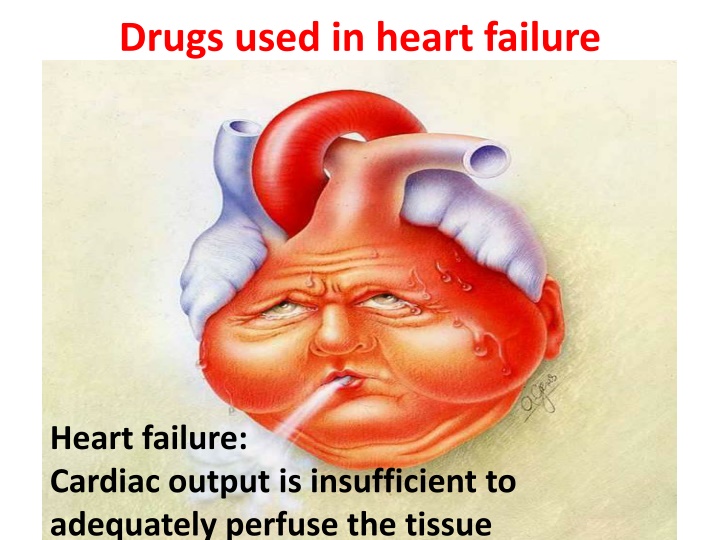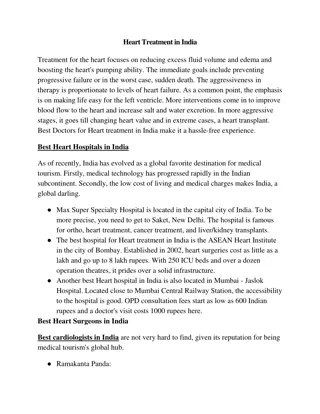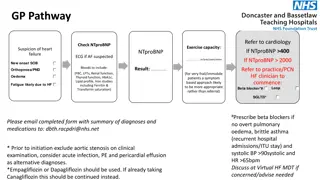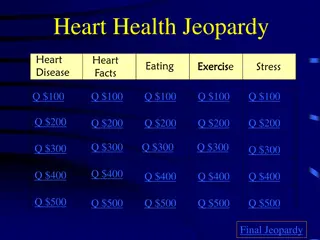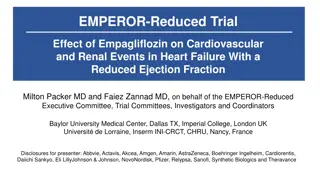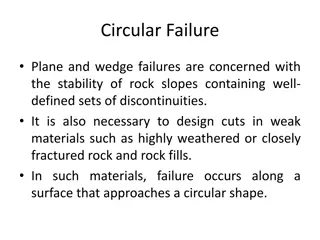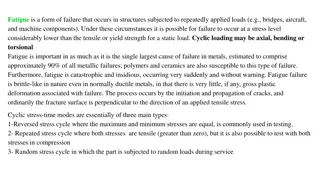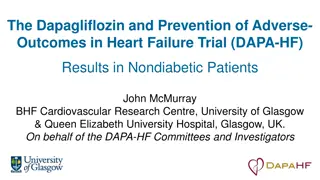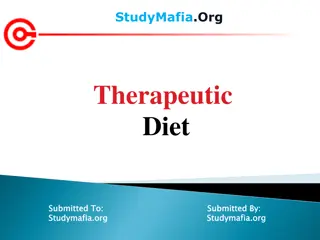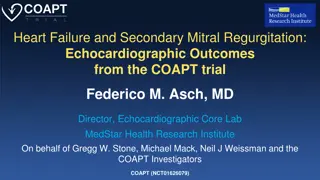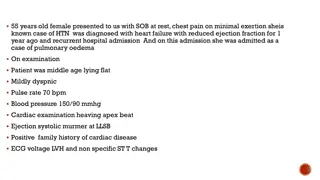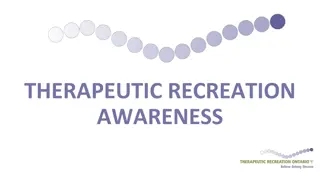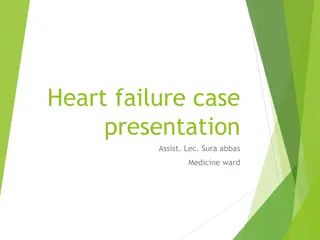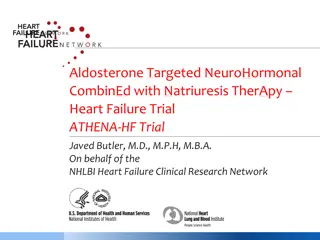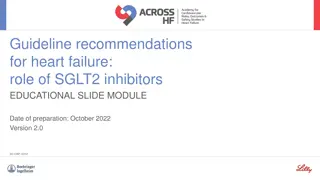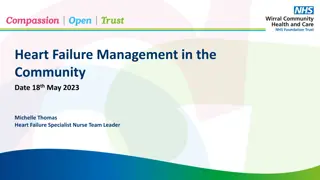Therapeutic Strategies in Heart Failure Management
Heart failure is a serious condition characterized by inadequate cardiac output. Compensatory responses include sympathetic nervous system activation, renin-angiotensin-aldosterone system stimulation, and natriuretic peptide release. Pharmacologic therapies target salt and water retention, afterload reduction, sympathetic stimulation, and cardiac contractility enhancement. Understanding these strategies is crucial in managing heart failure effectively.
Download Presentation

Please find below an Image/Link to download the presentation.
The content on the website is provided AS IS for your information and personal use only. It may not be sold, licensed, or shared on other websites without obtaining consent from the author.If you encounter any issues during the download, it is possible that the publisher has removed the file from their server.
You are allowed to download the files provided on this website for personal or commercial use, subject to the condition that they are used lawfully. All files are the property of their respective owners.
The content on the website is provided AS IS for your information and personal use only. It may not be sold, licensed, or shared on other websites without obtaining consent from the author.
E N D
Presentation Transcript
Drugs used in heart failure Heart failure: Cardiac output is insufficient to adequately perfuse the tissue
Heart failure Is an extremely serious cardiac condition associated with high mortality. The fundamental physiologic defect in heart failure is a decrease in cardiac output relative to the needs of the body, and the major manifestations are dyspnea and fatigue. It is frequently associated with chronic hypertension, valvular disease, coronary artery disease (MI), and cardiomyopathies.
Heart failure Preload: is the cardiac filling pressure of the left ventricle (venous return) Afterload: the resistance made by the blood vessels The homeostatic responses to depressed cardiac output are extremely important and are mediated mainly by the sympathetic nervous system and the renin-angiotensin- aldosterone system.
Compensatory physiological responses in heart failure A. Stimulation of sympathetic nervous system B. Stimulation Renin-Angiotensin-Adosterone syst. Leading to: 1. Tachycardia, force of contraction & vasoconst. 2. Retention of salt & water 3. of preload & afterload 4. Remodeling of cardiac tissue & loss of myocytes 5. Myocardial hypertrophy & fibrosis This creating a vicious cycle leads to death if no treatment.
C. Activation of natriuretic peptides The increase in preload causes release of atrial & B-type NUP This results in vasodilation, natriuresis, inhibition of renin & aldosterone release, and a reduction in myocardial fibrosis. This beneficial response may improve cardiac function.
THERAPEUTIC STRATEGIES Pharmacologic therapies for heart include the removal of retained salt and water with diuretics; Reduction of afterload and salt and water retention by means of angiotensin-converting enzyme (ACE) inhibitors; Reduction of excessive sympathetic stimulation by means of blockers; Reduction of preload/afterload with vasodilators; And in systolic failure, direct augmentation of cardiac contractility with positive inotropic drugs such as digitalis glycosides.
Drugs useful in heart failure: 1. Reduce the preload; diuretics, angiotensin converting enzyme inhibitors (ACEIs), nitrates 2. Reduce the afterload; ACEIs, hydralazine 3. Inotropic drugs: cardiac glycosides, phosphodiesterase inhibitors (PDIs, milrinone), 4. Beta agonists (dobutamine) 5. -blockers 6. B-natriuretic peptide (BNP): nesiritide 7. Others : Sacubitril, SGLT2 inhibitors
Angiotensin converting enzyme inhibitors: Captopril, enalapril and Lisinopril Inhibit ACE so inhibits conversion of angiotensin I to angiotensin II, lead to vasodilatation (arterial and venous) so reduce preload and afterload Reduce aldosterone release (to increase Na+ and water excretion), so reduce blood volume and venous return to the heart They improve survival in heart failure Angiotensin receptors antagonists as losartan and valsartan has similar effects and can be used instead of ACEIs if adverse effects (dry cough) occur
Diuretics in heart failure Include the thiazides, loop diuretics and potassium sparing diuretics Increase sodium and water excretion useful in oedema and dyspnea of heart failure and reduce the preload In mild heart failure usually thiazides diuretics are used, while in severe heart failure loop diuretics are preferred as frusemide Spironolactone confer a survival & symptomatic benefit
Vasodilators in heart failure Nitrates acts mainly by reducing the preload of the heart, they are mainly venodiators so reduce the venous return to the heart. Arterial dilators like hydralazine reduce afterload. Combination of hydralazine/isosorbide dinitrate improve symptoms & survival in black patients. Nitroglycerine is used in acute heart failure as injection or sublingually
What is the role of -blockers in HF? -blockers decrease myocardial contractility (negative inotropic) and may worsen acute/unstable heart failure. -blockers is recommended for chronic stable HF. -blockers was shown to improve survival in heart failure & reduce risk of death by arrhythmias. This seems to be due to the following effects: 1.blocking the overactive sympathetic activity 2.Reverse cardiac remodeling & hypertrophy. 3. Reduce renin release Commonly used -blockers include carvedilol, bisoprolol and metoprolol.
Digoxin Cardiac glycosides Include digoxin, digitoxin are extract of the plant called foxglove. Digitalis are no longer considered first-line drugs in the treatment of heart failure. Mechanism of action Inhibition of Na+/K+ ATPase sodium pump of the cell membrane by digitalis is well documented, this lead to increase intracellular Na+. intracellular Na+ lead to intracellular Ca++ by reducing Na+/Ca++ exchanger, so force of myocardial contraction
Pharmacokinetics Absorbed well from GIT, it is lipid soluble Low protein binding (20-30%) Mainly excreted unchanged by the kidneys Has narrow therapeutic index, therapeutic serum levels (1ng/ml) Clinical uses 1. Congestive cardiac failure 2. Atrial fibrillation in HF
Adverse effects GIT nausea, vomiting and diarrhea Cardiac arrhythmias and conduction defect CNS; weakness, dizziness, fatigue, confusion, visual disturbances and psychosis Gynaecomastia and skin rashes Note : Diuretics cause hypokalemia which aggravate digoxin toxicity
Phosphodiesterase inhibitors: a drugs that inhibit enzymes that degrade cAMP and cause an increase in cardiac intracellular calcium similar to that produced by -agonists. Examples: theophylline (aminophyllin), milrinone Milrinone increase intracellular calcium & contractility. Iv infusion for short-term treatment. Recombinant B-type natriuretic peptide (BNP) When IV diuretics is minimally effective, a nesiritide can be used in acute HF to stimulate natriuresis & diuresis and vasodilation to reduce preload & afterload.
Drugs useful in acute left ventricular failure (pulmonary oedema) Medical emergency that require rapid treatment Loop diuretic as furosemide is given i.v Morphine is useful when given i.v, i.m or s.c It improves anxiety and reduces the tachypnoea and might dilate the pulmonary vessels Vasodilators as nitrates, sodium nitroprusside and hydralazine might be useful Dobutamin or phosphodiesterase inhibitor
Angiotensin receptor-neprilysin inhibitor (ARNI) Neprilysin enzyme is responsible for breaking down of vasoactive peptides (angiotensin I&II, bradykinin, and natriuretic peptides), and inhibition augments activity. To maximize the effect of natriuretic peptides, stimulation of RAA System is prevented by combination with ARB, but not ACEI? To avoid further bradykinin. Sacubitril/Valsartan combination replace ACEI or ARB if no response. Sacubitril is a recently approved new drug molecule that combines the ARB valsartan with the neprilysin inhibitor sacubitril. Clinical studies suggest that this combination agent prolongs life and reduces hospitalizations in severe heart failure.
Current clinical evidence suggests that Acute HF: a loop diuretic, a positive inotropic (dobutamin or phosphodiesterase inhibitor), and vasodilator. Nesiritide, a recombinant form of brain natriuretic peptide (BNP), has vasodilating and diuretic properties and has been heavily promoted for use in acute failure. Chronic failure: diuretics (often a loop agent plus spironolactone) plus an ACEI and, a blocker. Digitalis if systolic dysfunction is prominent. A newer combination drug, sacubitril/valsartan, combines the actions of increased endogenous BNP, with those of the angiotensin receptor blocker valsartan in chronic HF. Anti-diabetes sodium-glucose cotransporter-2 (SGLT-2) inhibitors recently used therapy with increased survival.
Hyperpolarization-activated cyclic nuclotide-gated (HCN)channel blockers Ivabradine is a heart rate lowering HCN inhibitor to cardiac pacemaker (SA node) result in slowing of depolarization & low HR without reduction in contractility. Used to improve symptoms when HR above 70 with contraindication of -blockers
Summary The totality of evidence now suggests that patients with HFrEF should be treated early with a combination of the four drugs: ARNI (angiotensin receptor-neprilysin inhibitors, Sacubitril), beta- blocker, MRA (Mineralocorticoid antagonist, Spironolactone, eplerenone) , and SGLT2 inhibitor (dapagliflozin, empagliflozin). In order to benefit from substantial and sustained reductions of mortality, hospitalizations, and symptoms. The important task is now to ensure access to this evidence-based therapy for all HFrEF patients.
MCQ A patient is newly diagnosed with asymptomatic heart failure. Which is the most appropriate drug for survival benefits? A. Furosemide B. Dobutamine C. Digoxine D. Lisinopril E. Hydralazine D
MCQ A 65-year-old woman has been admitted to the coronary care unit with a left ventricular myocardial infarction. She develops acute severe heart failure with marked pulmonary edema, but no evidence of peripheral edema. Which one of the following drugs would be most useful? (A) Digoxin (B) Furosemide (C) Minoxidil (D) Propranolol (E) Spironolactone B
MCQ -blockers improve cardiac function and survival in HF by A. Decreasing cardiac remodeling B. Increasing HR C. Increasing renin release D. Activating noradrenaline E. All of the above A
MCQ All the following drugs improve survival in heart failure except. A. Angiotensin converting enzyme inhibitors (ACEI) B. Sacubitril/Valsartan combination C. Beta adrenergic blockers D. Digoxin E. Spironolactone D
MCQ Which of the following drugs increases the plasma levels of endogenous BNP and also blocks angiotensin receptors? (A) Furosemide (B) Losartan (C) Nesiritide (D) Sacubitril (E) Spironolactone D
